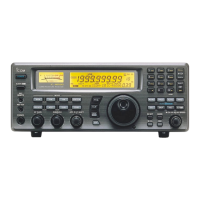4-1-15
AF AMPLIFIER
CIRCUIT (MAIN
UNIT)
The AF
amplilier
circuit amplifies the demodulated AF
signals to drive a
speaker.
AF
signals from the
squelch control
gate are pre-amplified
at
the AF
amplifier (IC20) and
are
then
applied
to the AF
power
amplifier
(1C21)
after either passing through or
by-
passing
the APF circuit (IC29-IC31, IC39). The power
amplified
AF signals are applied to the Internal
speaker via
the [EXT SP] and
[PHONE] jacks
when
no
plugs are con-
nected to the jacks.
The [AF GAIN]
control
signal is also applied to the AF
pre-amplifier
(IC20.
pin
8)
via
the CPU (IC33) to control
amplifying
gain.
4-1-16
NOISE
BLANKER CIRCUIT
(MAIN UNIT)
The noise blanker
circuit detects
pulse-type
noises, and
stops IF
amplifier
operation during detection.
A
portion of the 3rd IF
signal from the bandpass filter (FIS)
is
amplified
at
the noise
amplifier circuit
(Q9,
105, Q11).
The
amplified signal
is rectified at the
noise detector circuit
(DiO)
for
conversion into DC voltage. The DC
voltage is
applied to
the NB
control circuit
(Q12, Q13)
to
control
the
NB
switch
(Q14).
Some
DC
voltage is fed back to
the noise amplifier circuit
(ICS)
via
the DC
amplifier
(QIO). The DC amplifier function
as an AGC
circuit
to
reduce
averaged noise.
Therefore,
the
noise blanker function shuts off pulse-type
noise only.
4-1-17
AGC CIRCUIT
(MAIN UNIT)
The AGC
(Auto
Gain Control) circuit reduces IF amplifier
gain to keep the
audio output
at
a constant
level.
A
portion of the 3rd IF signal from the IF
amplifier
(Q18)
is
applied to the AGC
detector circuit (D20).
The
detected
signal
is
applied
to
the
AGC
control circuit
(Q20,
Q21
,
Q25,
Q27)
and then
applied to the IF amplifiers
(Q2,
Q4,
Q15-Q17). The AGC
voltage is also
applied
to
the
RF-A
and RF-B
unit
via the current-amplifier circuit (lC32b). The
current-amplified AGC signal is applied to the IF amplifier
and AGC
control
circuit in the RF-A unit (IF amp.:
Q8,
AGC
control:
Q3),
and the
buffer-amplifier circuit in the RF-B unit
(ICIa).
When strong
signals
are
received,
the detected
voltage
increases and the output level of the AGC control circuit
decreases. The
AGC
voltage is used as the bias
voltage
for
the
IF
amplifiers, therefore, the IF amplifier gain is de-
creased.
AGC
response time is controlled
by
changing the time
constant at the AGC
control line with resistors
(R179, R180,
R503) and
capacitors
(C134-C137). R179. R180, Cl 34
and
C135
are used for
AGC
slow, and
R503,
C136
and
Cl 37 are used tor AGC fast mode's
time constant. The
time constant for AGC slow is connected to the AGC
control
line- while AGC is set to slow. However, it's disconnected
from the AGC
control line, and the time constant for AGC
fast is connected to the AGC
control
line
while
AGC
is set
to
fast. Both time constants
are
disconnected from the AGC
control line
while scanning or when WFM or FM mode
is
selected
for
faster response than
AGC
fast
mode.
4-1-18
S-METER CIRCUIT (MAIN UNip
The S-meter circuit indicates the
relative
received signal
strength while receiving
and changes
depending
on the
received signal strength.
A portion of the
AGC
signal is applied to the meter amplifier
circuit (IC9a). The amplified
signal
is then applied to the
CPU
(IC33) as an SMAD signal
to drive
the S-meter.
*
The SMAD
signal
is
also used for noise and S-meter
^
squelch
operation
by
comparison with the
[SQUELCH]
control
setting
level and receiving signal strength
at the
CPU.
4-1-19
APF CIRCUIT (MAIN UNIT)
The
APF (Audio
Peak
Filter)
circuit boosts a
specified
frequency to pick up
desired
CW
signals,
etc.
When [APF] is turned ON, the AF signals from the squelch
control gate (IC19) are applied
to
the
APF
circuit
(IC29-IC31, IC39).
The [APF] control adjusts the peak
frequency within
200-1
000 Hz. IC29
is a
triple 2-channel
analog switch IC and the AF
signals
are either passed
through
or bypass the
APF circuit.
The APF circuit
functions
as a tone control while
WFM,
FM,
AM
or SSB mode is
selected.
•
Noise blanker and AGC
circuits
4-5

